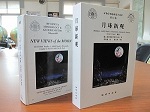Institute of Meteoritics News
A Tribute to Dr. James Joseph Papike

James Joseph Papike, known as “Jim” or “JJP” to his friends and colleagues, passed away on December 21st, 2020 just two days after the loss of his wife and life-long partner, Pauline.
While at the University of New Mexico (UNM), Jim was director of the Institute of Meteoritics (IOM) and Professor in the Department of Earth and Planetary Sciences from 1990 to 2003. During his tenure as Director he greatly expanded the analytical facilities of the IOM. Even after stepping down from those positions in 2002 (he hated the word retirement) he continued to be engaged in his second love, planetary science research. Over the last two decades, only those who came into Northrop prior to 6 AM were fortunate enough to make a “Papike” sighting without an appointment. To his many students, friends and acquaintances, Jim was a mineralogist, crystallographer, petrologist, geochemist, geological engineer, promoter of planetary sample return, a meteoriticist, a Lunatic, a hockey player, an ice fisherman extraordinaire, dog lover, or an Iron Ranger, to name a few. Take your pick or take them all.
Jim was born and raised in the iron range of northern Minnesota. He completed his bachelor’s degree in Geological Engineering at the South Dakota School of Mines and Technology. He then returned to Minnesota, where he received his doctorate in Geology from the University of Minnesota. A natural leader, in the course of his long career Jim was a major presence at six institutions (United States Geological Survey, Stony Brook University, Arizona State University, South Dakota School of Mines and Technology, University of Tsukuba, and the University of New Mexico).
Prior to arriving at the UNM he was Director of the Institute for the Study of Mineral Deposits at the South Dakota School of Mines and Technology. He influenced the research community through his mentoring of many undergraduate and graduate students, post-doctoral research associates and early career professionals, and through his participation and leadership in over 40 national committees, spanning everything from Apollo Site Selection and Continental Scientific Drilling to Department of Energy working groups on geologic disposal of nuclear waste. He was active in, and had been an officer or councilor in, the Mineralogical Society of America (president), the American Geophysical Union, the Geochemical Society (president), the Society of Economic Geologists, the National Academy of Sciences, the Universities Space Research Association, and numerous other professional organizations.
He was always ahead of the curve in anticipating new questions worthy of major initiatives as well as innovative analytical approaches to reexamine science problems. His thorough review papers are classics that will continue to be cited for many years to come. In sum, he had been a presence at institutions of amazing diversity across the breadth and depth of this country and overseas. More than this, Jim had a prominent physical and intellectual presence that left an impression not just on the scientists he interacted with, but also the public.
There is much more to Jim than you will find in this short remembrance. Trade stories with his many friends, colleagues, and students to get a real appreciation of our loss. Thanks Jim, for everything. Jim and Pauline are survived by three daughters, eight grandchildren, and six great-grandchildren.
Prepared by Dr. Charles Shearer and Dr. Steven Simon
IOM Director Carl Agee has been appointed President of The Consortium for Materials Properties Research in Earth Sciences (COMPRES) beginning September 2015.
Graduate Student Kathleen Vander Kaaden has been awarded the NASA Earth and Space Science (NESSF) Graduate Student Fellowship award for the 2015-16 academic year for research work in the area of Planetary Science.
Senior Scientist Karen Ziegler conducted oxygen isotope analyses on the Chelyabinsk meteorite which fell in Russia in February 2013.
Carl Agee, director and curator of the IOM, and a team of researchers--including groups at UNM, UC San Diego and the Carnegie Institution--have identified a new class of Martian meteorite that fell to Earth and likely originated from the planet’s crust and surface environment. The research was published in the journal Science, and articles about the work have been appeared at NBCnews.com, Nature and Discover magazine. Watch the video to see the team discussing their findings.
Francis McCubbin, Senior Scientist, received a Presidential Early Career Awards for Scientists and Engineers (PECASE), the highest honor bestowed by the United States Government on science and engineering professionals in the early stages of their independent research careers. Dr. McCubbin received his award in a ceremony at the White House. McCubbin was recognized for studies of the geochemical role of water and other volatiles in extraterrestrial materials from the inner solar system. Francis was also interviewed recently by National Geographic about his article in Geology (which includes UNM co-authors Stephen Elardo, Kathleen Vander Kaaden and Charles Shearer) and NewScientist about an article which appeared in Science (DOI: 10.1126/science.1220715).
 Senior Scientist Charles Shearer’s book, “New Views of the Moon” (Reviews in Mineralogy, Vol. 60, Mineralogical Society of America 2006), has been published in a Chinese edition.
Senior Scientist Charles Shearer’s book, “New Views of the Moon” (Reviews in Mineralogy, Vol. 60, Mineralogical Society of America 2006), has been published in a Chinese edition.
Two IOM graduate students and one undergraduate received grants from the New Mexico Space Grant Consortium for the 2013-2014 school year. Master's student Suzi Gordon was awarded $10,000 for her research titled “Igneous formation of the Martian crust: constraints from remote sensing, in situ, and Martian meteorite measurements.” Alison Santos, a Ph.D. student, was awarded $10,000 for her project “A Geochemical Investigation of Martian Meteorite NWA 7034.” Joshua Williams, a senior, was awarded $5,000 for his research titled “MSL ChemCam Affiliate.”